That Was the Week That Was
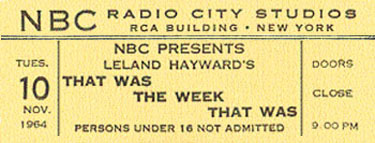
That Was the Week That Was was an acclaimed but short-lived satiric show in England then again in America. The British version went on the air in November of 1962 and went off at the end of ’63. One of its last episodes was among its most memorable: A shortened episode that paid tribute to John F. Kennedy shortly after his assassination. The audio from it was released as a record album and it remains one of the few relics of that live show. Other weeks, it was songs and sketches about what was happening in the world with David Frost as its host.
The pilot for an Americanized version aired in this country on November 10, 1963. Ratings were soft but critics raved about the show which was also headed up by David Frost and which started his rise to fame in the U.S. A weekly version commenced on January 10, 1964. Frost, commuting from the U.K., continued to host or at least dominate the proceedings. Nancy Ames was the “TW3 Girl,” singing the title and closing song which each week featured new and topical lyrics. The rest of the cast changed from week to week but at times included Henry Morgan, Alan Alda, Mike Nichols & Elaine May, Elliot Reid, Buck Henry and many more. For a half hour, they’d talk about items in the news and parody whatever there was to parody.
There were two other notable contributors though you didn’t see much of either on screen. Comedy songwriter Tom Lehrer wrote tunes, many of which he later recorded and put out as an album entitled That Was the Year That Was. And puppeteer Burr Tillstrom, best known for the kids show Kukla, Fran & Ollie invented a new art form with what he called “Hand Ballets.” They were little vignettes set to music in which Tillstrom used his bare hands as puppets and would mime some in-the-news situation. The most memorable one was an interpretation of the Berlin Wall. One of Tillstrom’s hands played the wall; the other represented a person who lived in East Berlin and who was in agony about being separated from his family on the other side of the wall/hand.
TW3 was a modest success in America and NBC kept it on the air expecting that it would draw extra attention during the ’64 Presidential Campaign. What they hadn’t reckoned with was this: It was then relatively easy and not all that expensive for a political candidate to buy a half-hour or even an hour of prime-time TV time. Most of the candidates did that, often pre-empting regular programming with little advance notice. You’d tune in to see your favorite show and discover it was not on and a political ad was in its place. The Republican National Committee took to buying the time slot for That Was the Week That Was, over and over just to keep it off the air and stifle its somewhat-liberal viewpoints. This was a special problem for TW3 as it was done live, and material written for one week was often out-of-date and unusable a few weeks later. Often, they would write and rehearse for several days and then find out that the show would not be airing; that a special touting Barry Goldwater for President would air instead. By the time TW3 did air again, it had lost its mojo and whatever steady viewers it had. It ended in May of ’65.
The ticket above is to a live broadcast that probably did air since it was one week after the election. Leland Hayward, who got billing over the title on tickets and some other places, was a show business entrepreneur who bounced back and forth between being an agent and a producer. His most notable work was on Broadway where he “produced” (i.e., put together the deals for) shows like Mister Roberts, Gypsy and The Sound of Music. His main contribution to That Was the Week That Was was probably just getting it on the air.
Hudson Brothers Show, The
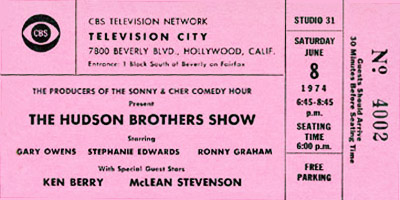
No sooner was The Sonny & Cher Comedy Hour a hit than its producers, Allan Blye and Chris Bearde, sought to replicate that success on Saturday morn with an act called The Hudson Brothers. Promoting Bill, Brett and Mark Hudson as the seventies version of Groucho, Harpo and Chico, CBS launched them as the summer replacement for Sonny and Cher, with a show that aired in primetime from 7/31/74 to 8/28/74. This segued into the half-hour Saturday AM version, which was called The Hudson Brothers Razzle Dazzle Show. That one lasted one year, commencing 8/7/74.
Both shows featured zany sketches and music (the Brothers had some modest record hits around then) and a family of regulars that included Gary Owens and Rod Hull. Rod Hull was an Australian comedian who worked with a large bird puppet called Emu. You can read all about Rod here.
Oddly enough, the primetime version — which had only been intended to launch the brothers in preparation for their Saturday morn show — probably fared better. There was talk of later bringing it or them back in some format but the act instead drifted through other venues and the Hudsons went their separate ways.
Redd Foxx Comedy Hour, The
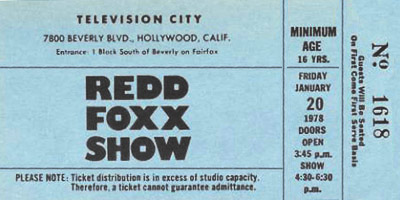
Here’s another ticket for a show that taped at CBS but as you can see from the absence of those letters on the ticket, the show didn’t air on CBS. It also wasn’t called The Redd Foxx Show like the ticket says. There was a later program called The Redd Foxx Show and it was a situation comedy. This one was a variety show that was broadcast on ABC as The Redd Foxx Comedy Hour.
Mr. Foxx starred in Sanford and Son from 1972 to 1977. When it was finally cancelled, he signed a big contract with ABC and this series resulted. It was produced by the team of Allan Blye and Bob Einstein, and it was a very funny, innovative series that not a lot of people watched. Foxx was joined by regulars Billy Barty, Bill Saluga and Hal Smith, along with some of his old nightclub cronies like Slappy White and “Iron Jaw” Wilson. “Iron Jaw” was a performer who was often on nightclub bills with Foxx as an opening act. His performance consisted of linking about a dozen lightweight wooden chairs into a cluster and lifting that assemblage up in his teeth. That was about all he did but Foxx kept him working. Andy Kaufman also appeared once or twice.
When Redd left NBC, there were press reports that the main point of contention had been that the network wouldn’t give him a dressing room with a window in it. The actual reason was that, given the success of Sanford and Son, he felt he deserved a lot more money than NBC was offering and also that he had more to offer than just playing Fred Sanford. He wanted, for example, to host variety specials and to guest host The Tonight Show — the latter, a demand that was vetoed by Johnny Carson. ABC offered a lot more…so off he went. The opening of his first telecast showed a shot of the ABC studio and an announcer introduced him. You then heard the voice of Redd Foxx yelling, “I ain’t comin’ out ’til I get a window!”
What followed was a funny show but America wasn’t watching. A bad time slot (Thursday nights at 10) was one reason. Another may have been that people really only loved him as Sanford. The only attention the series got was when they did a sketch spoofing Farrah Fawcett’s then-famous hair-do, It was a visit to her home where everyone — including her parents, the maid and a parrot — wore Farrah wigs. The actress sued and ABC settled with a promise that her coiffure would not be mocked on any ABC show. For a couple years there, the main taboo on an ABC show was any joke that mentioned Farrah Fawcett. Other networks could and did make fun of her but it was verboten on ABC.
Records show that The Redd Foxx Comedy Hour debuted on September 15, 1977 and last aired on January 26, 1978. The above ticket is for January 20, which makes one suspect the taping either didn’t occur or that it resulted in a show that never aired. By March of 1980, Redd Foxx was back on series television…playing Fred Sanford again.
Wilton North Report
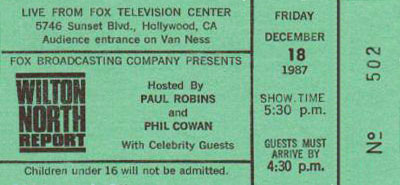
The Late Show With Joan Rivers was the first attempt by the then-new Fox Network to launch late night programming in competion with the seemingly-indestructible Johnny Carson. When Ms. Rivers crashed and burned, she disappeared suddenly from the show and was replaced by a couple of guest hosts while Fox scurried to come up with something else for the time slot. Just when Arsenio Hall began clicking as host of The Late Show, the new program was ready…and Arsenio fled elsewhere, becoming (for a time) a lot more successful than his replacement on Fox and giving Mr. Carson a brief, unprecedented dosage of competion.
The new Fox show was the Wilton North Report — which, like the earlier mock sitcom Mary Hartman, Mary Hartman, drew its name from the geography near the studio. Ms. Hartman lived in Fernwood, a street which bordered the KTTV Studios. Wilton was another such street and it seemed like a dandy name to hang on a show of fake news. Similar in concept to the later, successful Daily Show on Comedy Central, the Wilton North Report didn’t look like such a hot idea when it debuted. Its hosts, Phil Cowan and Paul Robins, were disc jockeys with little TV experience. The producer, Barry Sand, had plenty having once produced David Letterman’s show in New York. The writing staff (which included a novice named Conan O’Brien) later faulted Sand for watering down the show and chopping out the best and most controversial moments.
The Wilton North Report debuted December 11, 1987. It was gone less than four weeks later but its ticket remains.
Ernie Kovacs Show, The (1955-1956)
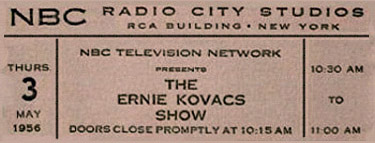
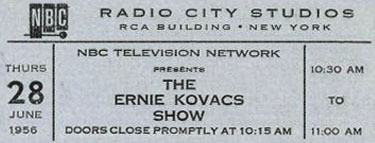
Ernie Kovacs spent much of the fifties wandering from network to network and show to show, doing essentially the same program. The critics loved him and his innovative brand of comedy. Audiences liked him but not enough to make any one show enough of a hit that he stayed in one gig for very long.
Today, when you see clips of his work, the emphasis is on silent bits that pushed the envelope of what was technically possible in television at that time. I always thought those compilations, though impressive, missed the point of Kovacs. First of all, a lot of the visual stuff was his wholly the work of his writers. (Kovacs isn’t even in some of the most-seen excerpts.) Secondly, some of them are merely a matter of replicating in a TV studio bits that had previously been done on film by Buster Keaton or Harold Lloyd or even — in the case of one clip in particular — The Three Stooges. That’s the one where he’s sitting on a tree branch, sawing off the branch he’s sitting on…and the tree falls while the branch remains in the air.
The clips that suggest Kovacs was worthy of his exalted reputation are the ones where he talks…as one of his characters (like the effeminate poet, Percy Dovetonsils) or even as Ernie Kovacs. He was a very funny man without the gimmicked props and the trick photography.
No one ever seems to have compiled a definitive list of all the shows that Kovacs starred in over the years. Some did not last long and there were even times when he was doing two shows at the same time. Most articles about him, for instance, will tell you of an hour-long prime-time series he did on Monday nights for NBC from December of 1955, lasting until the following September. It was called The Ernie Kovacs Show but the above tickets are from a rarely-mentioned half hour daily morning show with the same name that he was doing during the same period. At some point in there, he stopped doing the morning show and was filling in for Steve Allen on Tonight.
Later on, there were other shows…on and off, here and there, until his death in a car crash in 1962. It robbed TV viewers of one of the funniest human beings they ever got to follow from show to show.
Jerry Lewis Show, The (1967-1969)
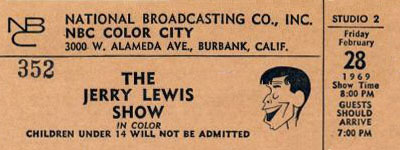
Jerry Lewis has had a checkered career on television. He and Dean Martin scored big on The Colgate Comedy Hour (1950-1955) where they were among the show’s rotating hosts. A series of specials did well but then in 1963, he attempted a two-hour live variety/talk show for ABC that was one of television’s most spectacular disasters. It was supposed to be a two-year “firm” committment but after dismal ratings and killer reviews, Lewis announced he was too busy with his film career to do television and exited after thirteen weeks.
Four years later, that film career was starting to fade and he reappeared on NBC with a more conventional variety series done, unlike his earlier efforts which were all live, on tape. It debuted on September 19, 1967 to indifferent response and disappointing ratings. (Lewis was said to have been unamused by the unidentified person who, the day before his debut, papered the NBC studios and Lewis’s car with signs that said, “Ban the bomb before it goes off.”) But NBC believed that Jerry might catch on, as his former partner had with The Dean Martin Show, and kept the fesitivities going for two years. The final broadcast was May 27, 1969.
It was not a great show. Jerry seemed to have trouble relating to any guest or topic that couldn’t have been on the old Colgate Comedy Hour. Many of the guests and jokes actually did date back that far. The sketches were weak and much of the show was devoted to Jerry’s questionable singing talents. Some people seem to recall that during this period, he and Dean exchanged cameo guest appearances but that never happened. Dean did, however, take time on his show to ask people to watch Jerry’s first episode.
Jerry Lewis never had another TV series after that…unless you count his annual Labor Day telethon to benefit Muscular Dystrophy. In 1984, he starred in a week of pilot episodes for a talk show. Thought he trotted out heavyweight guest stars — including Frank Sinatra on the opener — the show didn’t click. Reviewers faulted it (rightly) for devoting way too much of its air time to the host, the guests and sidekick Charlie Callas all discussing the greatness of each other. Since then, Jer has been a frequent guest star on other shows, slowly ascending to Legend status. My favorite of all his appearances was one night when he was on with David Letterman and Dave asked him, as a personal favor, just to run around the stage and act crazy. Jerry was a bit puzzled but he obliged.
Jonathan Winters Show, The (1967-1969)

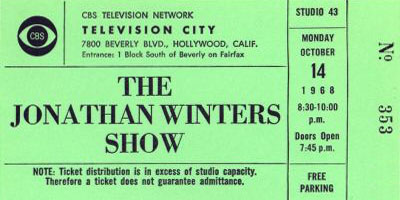
I doubt there’s a comedian anywhere who doesn’t hail Jonathan Winters as one of the greats, and whenever I’ve been around the man, I’ve seen an unending stream of people stop to tell him he’s the funniest man alive. With such unanimity of opinion, it’s amazing that Winters hasn’t had more steady work on television. What he does, he does better than anyone…but producers have sometimes been unable to package it in a format that fit neatly into a TV schedule.
The first Jonathan Winters Show was a fifteen-minute program that ran from 1956 to 1957 on NBC, following the evening newscast which then was fifteen minutes in length. It lasted about nine months.
In the mid-sixties, Winters starred in a string of network specials that got high ratings and good reviews, and appeared as a semi-regular on The Andy Williams Show. It all led to CBS, in 1967, installing him in the second Jonathan Winters Show. Most of the show consisted of sketches in which Winters played characters from his repertoire, especially the irrepressible Maude Frickert. Comedian Dick Curtis appeared in most sketches, usually as straight man, and one of the show’s producers, John Aylesworth, functioned as announcer and occasional performer. In addition to them, a number of stars turned up often enough to be considered semi-regulars: Abby Dalton, Paul Lynde, Alice Ghostley, Minnie Pearl and Cliff “Charley Weaver” Arquette.
The highlight of most episodes was the opening, which pretty much consisted of Jonathan standing on stage, letting the audience suggest characters and scenes for him to improvise. Folks at the network suggested that the staff devise some good premises and have them planted among the legitimate suggestions, but Jonathan insisted that not be done. A friend of mine who worked on the show said it wasn’t done and it wasn’t necessary…though of course, they did tape much more than was needed and edit it down for air.
The two above tickets are for the dress rehearsal and taping for the episode produced on October 14, 1968, midway through its second and final season. Later, Winters starred in several other shows, specials and unsuccessful pilots but there never seemed to be a permanent home on TV for the funniest man alive. Our loss.
Red Skelton Show, The
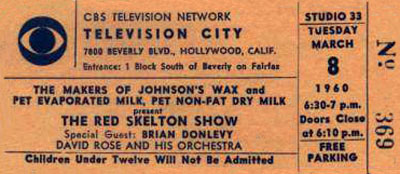

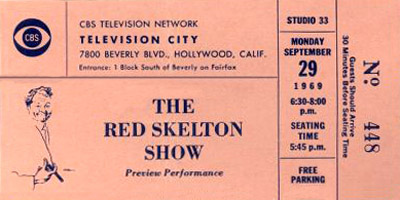
Tickets to TV tapings are free, of course. But they could have made a fortune charging to see Red Skelton rehearse; that is, if they raised the minimum age to 21. As I explained in this article, Mr. Skelton’s dress rehearsals consisted of ignoring that week’s scripts and telling dirty jokes to the crew and a contingent of CBS secretaries and employees who filled the audience. And here are the key questions: If you were the maker of Pet Evaporated Milk, would you really want to publicize that you also made Johnson’s Wax? Just how do you benefit from connecting those two products in the minds of the American public? And what the heck ever happened to Brian Donlevy?
There’s some odd terminology on two of the above tickets. Skelton, when he did his show at CBS, would do a “preview” performance on Monday night for a live audience — not to be confused with his ribald dress rehearsals, for which there were no tickets. Then the script would be revised and rehearsed for a Tuesday evening taping. But in most cases, a ticket that says “a special preview” is a ticket to watch a tape or film of a show that was shot without a live audience. Some shows have done that — shot without the public present, then brought an audience in, shown them the program and recorded their laughter and applause to dub into the show. That doesn’t seem to have been the case with the second and third tickets above, especially the one that says “preview performance.” Both were probably tickets to watch Red Skelton and his guests do the entire show live…but they don’t look it.
Sonny & Cher Comedy Hour, The
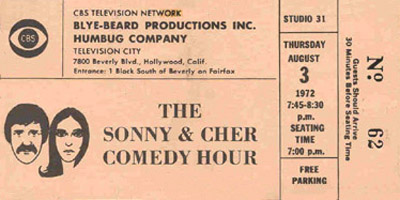
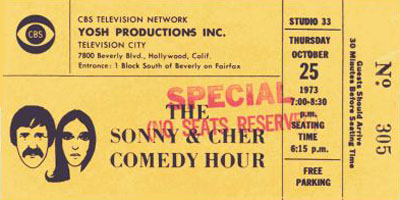
These tickets aren’t from my collection but I actually went to see them tape The Sonny & Cher Comedy Hour around this time. My first memory is of an excruciatingly long wait to get in. Well past the hour given for Seating Time, we were still standing outside, and in the hot sun and in an area without anywhere to sit. (CBS soon rearranged their audience areas so this is no longer true.) A lot of folks gave up waiting and left and we were about to when we were suddenly admitted…whereupon we got to wait a very long time inside Studio 33, a legendary place in television history, but still not a place you’d want to sit and wait for too long.
Finally, the producer welcomed us, and Sonny Bono and his then-wife came out and did the opening spot of the show, including a song. Then they taped the closing spot and exited to great applause that could continue under the credits. During all of this, the producer, Sonny and Cher kept talking about the great guest stars they had this week, and we kinda assumed we’d be seeing some of them. As it turned out, all the comedy sketches had already been taped without an audience. (They’d be sweetened with canned laughter, but of course the home viewers would see us, the live audience, at the beginning and end of the show, and would probably assume we’d been there throughout and that that was us howling with glee.) The producer explained that the sketches had to be taped without an audience “for technical reasons,” but I later worked with that producer and found that he just preferred to do it that way.
The only other thing we got to see was a musical number by that evening’s musical guests, The Grass Roots. The song was “Sooner or Later,” and one of the reasons I can recall that title is because they sang it — actually, lip-synched to what I think was their record — about eight times so that the cameras could get it from a wide array of angles. At least, I think it was eight. We left about the time it started to seem like eight. On the way out, we ran into a young lady — a devout Sonny/Cher fan we’d been chatting with in line. The lady was almost in tears. She’d brought something she hoped to get Cher to sign, and had left the taping after the fifth take of “Sooner or Later” to get outside the Artists’ Entrance in the hope of an encounter. A guard there told her that Cher and Sonny had both left twenty minutes earlier. In other words, we’d stayed at the taping of The Sonny & Cher Comedy Hour longer than either Sonny or Cher.






